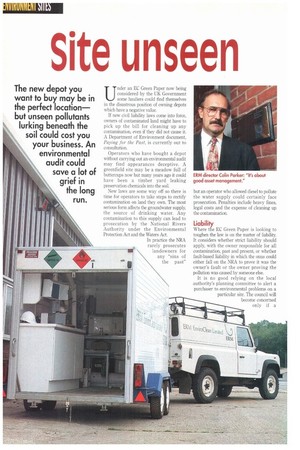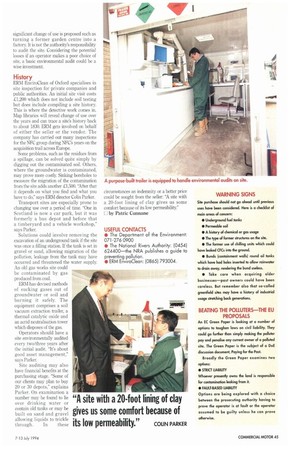Site unseen
Page 46

Page 47

If you've noticed an error in this article please click here to report it so we can fix it.
The new depot you want to buy may be in the perfect location— but unseen pollutants lurking beneath the soil could cost you your business. An environmental audit could save a lot of grief in the long run.
Under an EC Green Paper now being considered by the UK Government some hauliers could find themselves in the disastrous position of owning depots which have a negative value.
If new civil liability laws come into force, owners of contaminated land might have to pick up the bill for cleaning up any contamination, even if they did not cause it. A Department of Environment document, Paying for the Past, is currently out to consultation.
Operators who have bought a depot without carrying out an environmental audit may find appearances deceptive. A greenfield site may be a meadow full of buttercups now but many years ago it could have been a timber yard leaking preservation chemicals into the soil.
New laws are some way off so there is time for operators to take steps to rectify contamination on land they own. The most serious form affects the groundwater supply, the source of drinking water. Any contamination to this supply can lead to prosecution by the National Rivers Authority under the Environmental Protection Act and the Waters Act.
In practice the NRA rarely prosecutes landowners for any "sins of the past" but an operator who allowed diesel to pollute the water supply could certainly face prosecution. Penalties include heavy fines, legal costs and the expense of cleaning up the contamination.
Liability
Where the EC Green Paper is looking to toughen the law is on the matter of liability. It considers whether strict liability should apply, with the owner responsible for all contamination, past and present, or whether fault-based liability in which the onus could either fall on the NRA to prove it was the owner's fault or the owner proving the pollution was caused by someone else. It is no good relying on the local authority's planning committee to alert a purchaser to environmental problems on a particular site. The council will become concerned only if a significant change of use is proposed such as turning a former garden centre into a factory. It is not the authority's responsibility to audit the site. Considering the potential losses if an operator makes a poor choice of site, a basic environmental audit could be a wise investment.
History
ERM EnviroClean of Oxford specialises in site inspection for private companies and public authorities. An initial site visit costs £1,200 which does not include soil testing but does include compiling a site history. This is where the detective work comes in. Map libraries will reveal change of use over the years and can trace a site's history back to about 1830. ERNI gets involved on behalf of either the seller or the vendor. The company has carried out many inspections for the NFC group during NFC's years on the acquisition trail across Europe.
Some problems, such as the residues from a spillage, can be solved quite simply by digging out the contaminated soil. Others, where the groundwater is contaminated, may prove more costly. Sinking boreholes to measure the migration of the contamination from the site adds another £1,500. "After that it depends on what you find and what you have to do," says ERM director Colin Parker.
Transport sites are especially prone to changing use over a period of time. "One in Scotland is now a car park, but it was formerly a bus depot and before that a timberyard and a vehicle workshop," says Parker.
Solutions could involve removing the excavation of an underground tank if the site was once a filling station. lithe tank is set in gravel or sand, allowing migration of the pollution, leakage from the tank may have occurred and threatened the water supply. An old gas works site could be contaminated by gas produced from coal.
ERM has devised methods of sucking gases out of groundwater or soil and burning it safely. The equipment comprises a soil vacuum extraction trailer, a thermal catalytic oxide and an acrid neutralisation tower which disposes of the gas.
Operators should have a site environmentally audited every two/three years after the initial audit. "It's about good asset management," says Parker.
Site auditing may also have financial benefits at the purchasing stage. "Some of our clients may plan to buy 20 or 30 depots," explains Parker. On examination a number may be found to lie over drinking water or contain old tanks or may be built on sand and gravel allowing liquids to trickle through. In these
circumstances an indemnity or a better price could be sought from the seller: "A site with a 20-foot lining of clay gives us some comfort because of its low permeability" Li by Patric Cunnane
USEFUL CONTACTS
• The Department of the Environment: 071-276 0900 • The National Rivers Authority: (0454) 624400—the NRA publishes a guide to preventing pollution. • ERM EnviroClean: (0865) 793004.
































































































